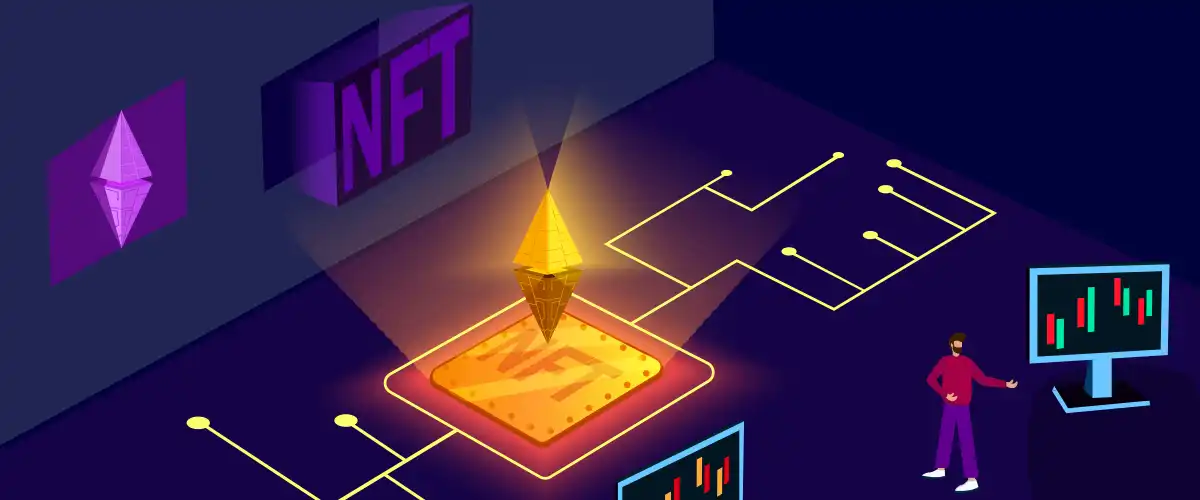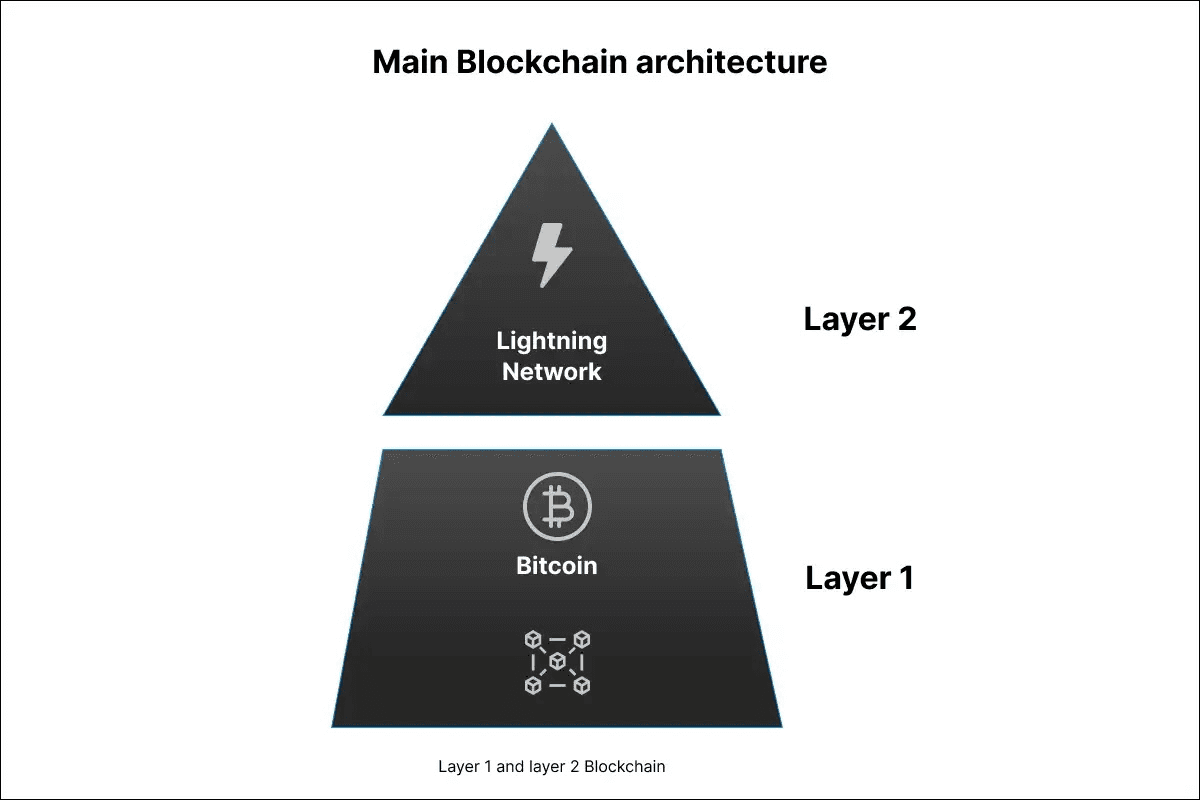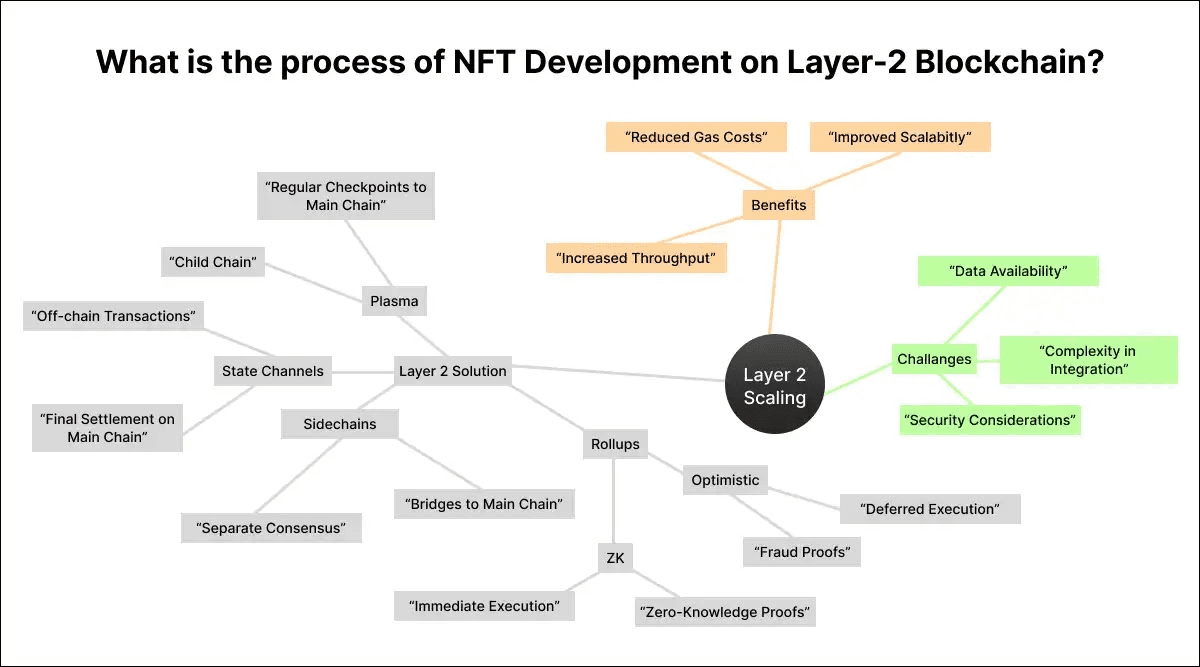How to Use Layer-2 Blockchain for NFT Development?
Apr 29, 2024



NFTs (Non-fungible tokens) are unique cryptographic tokens that represent digital or real-world items. NFTs exist on a Blockchain indicating ownership or authenticating the real-world items. However, Ethereum, the main platform for NFT creation, faces challenges. High fees, network clogs, and scaling troubles restrict widespread NFT use. Luckily, Layer-2 blockchain development offers innovative solutions to overcome these hurdles. They streamline NFT adoption, paving the way for unbounded creative expression.

What are Layer-2 Blockchains?
Blockchains have different layers that work together. Layer-1 is the base layer, like Ethereum, where all the transactions happen. But sometimes there are too many transactions, and it gets slow and expensive. That's where Layer 2 comes in.
Layer-2 blockchains are built on top of Layer-1 to help make things faster and cheaper. They use special tricks like sidechains, state channels, and rollups. Sidechains are like separate chains that run alongside the main chain. State channels are like private highways for transactions between two parties.
Rollups bundle up lots of transactions and process them off the main chain, then add the final result to the Layer-1 chain. All these tricks help Layer-2 blockchains handle more transactions quickly and cheaply.
How to Choose the Right Layer-2 Solution?
Picking the ideal Layer-2 blockchain for NFTs calls for a tactical approach. It ensures optimal performance, security, and compatibility.
First, assess project needs (like transaction volume, latency, and security).Before selecting Layer-2 solutions, carefully evaluate your project's specific requirements. Key factors include anticipated transaction volume, desired transaction speed, and the level of security required for your NFT ecosystem. These factors will guide your choice.
Next, evaluate available Layer-2 options (Optimistic Rollups, ZK-Rollups, Validium).Layer 2 offers diverse options, each with unique strengths and trade-offs. Optimistic Rollups like Arbitrum rely on fraud proofs for security, while Zero-Knowledge (ZK) Rollups like zkSync Era used advanced cryptography for scalability and privacy.
While Layer-2 blockchains operate independently, interoperability with the main chain (e.g., Ethereum) is crucial for smooth integration and user experience. Evaluate the compatibility of your chosen Layer-2 solution with the main chain to ensure smooth bridging of assets and data between the two layers.
What is the process of NFT Development on Layer-2 Blockchain?
Once you've selected the appropriate Layer-2 solution, the process of NFT development can commence:
First, you'll need to develop smart contracts that govern the rules and logic of your NFT ecosystem. These contracts define the processes for minting, trading, and managing NFT ownership. Ensure your contracts comply with widely adopted NFT metadata standards like ERC-721 and ERC-1155 to ensure compatibility with existing marketplaces and wallets.
Next utilises the Layer-2 blockchain's capabilities to tokenize digital assets as NFTs and mint them securely and efficiently. This process is optimised for faster transaction speeds and lower fees compared to Layer-1 blockchains.
Integrate your NFT ecosystem with popular NFT marketplaces to reach a wider audience and benefit from the faster transaction speeds and lower fees offered by Layer-2 solutions. This integration allows for seamless trading and ownership transfers.
Finally, optimize the overall user experience by using the benefits of Layer-2 blockchains. Near-instant transaction confirmations and negligible transaction fees provide a smooth and cost-effective experience for users interacting with your NFT ecosystem.

What are the benefits of developing NFTs on Layer-2 Blockchains?
Developing non-fungible tokens on Layer-2 blockchains delivers various advantages compared to traditional Layer-1 platforms. These advantages include lightning-fast transaction speeds, free peer-to-peer trading, customizable costs, superior scalability, and a decentralised sidechain structure. Let's dig deeper into these remarkable features.
1. Rapid Transactions:
Layer-2 solutions are designed for blistering transaction speeds, exceeding an astonishing 9,000 transactions per second (TPS). This incredible throughput ensures instantaneous interactions within the NFT ecosystem, changing the user experience. Whether minting, buying, or transferring NFTs, the process is smooth and hassle-free, eliminating frustrating delays.
2. Fee-less Peer-to-Peer Trades:
Let’s imagine you can trade NFTs without incurring any fees whatsoever. Layer-2 blockchains make this dream a reality by facilitating fee-less peer-to-peer trading interactions. This groundbreaking feature democratises the NFT market, making it accessible to everyone, regardless of their financial standing. No more worrying about exorbitant gas fees or hidden costs – the NFT ecosystem becomes a truly inclusive space for creators and collectors alike.
3. Adjusted Trading Costs Tailored to Your Needs:
Companies have the power to establish and monitor their trading costs. This remarkable feature offers unparalleled flexibility and customization options, catering to the unique requirements of diverse NFT projects. By using this capability, businesses can create a smooth trading experience that aligns perfectly with their objectives and vision for their NFT ecosystem.
4. Unparalleled Expansion Potential:
Layer-2 solutions bring forth a groundbreaking advantage – superior scalability. This capability empowers NFT ecosystems to expand and grow without compromising on efficiency. By using Layer-2 technologies, the once-formidable barriers to scaling are shattered, paving the way for boundless growth and limitless possibilities within the dynamic world of NFTs.
Interacting with Multi-Chain Development
The blockchain world is rapidly changing. Building on different blockchains has become popular. Layer-2 blockchains are crucial for allowing NFTs to move between different blockchain networks. They act as bridges, connecting various blockchain ecosystems.
Using Layer-2 solutions, developers can create pathways for NFTs to seamlessly move across Layer-1 and Layer-2 blockchains. This ability to travel between networks makes NFTs more accessible and liquid. It opens up exciting opportunities for NFT applications that span multiple blockchains.
Conclusion
NFTs, or Non-Fungible tokens, are special tokens that live on blockchain networks. However, popular networks like Ethereum struggle with scalability and high transaction fees, making it hard to buy, sell, and use NFTs easily. This is where Layer-2 blockchains come in to help.
Layer-2 networks run on top of the main blockchain network. They take some of the heavy load from the main chain, allowing for faster and cheaper transactions. By carefully selecting the right Layer-2 solution, developers can make it much easier and more affordable for people to use and enjoy NFTs.
As more and more people get interested in NFTs, it's becoming super important for blockchain developers to start using Layer-2 networks. At DecentraBlock, our expert developers are developing advanced solutions to solve many of the speed and cost issues that have been holding NFTs back. With Layer 2, our blockchain developers can make advanced NFT projects that are accessible and eco-friendly. People can buy, trade, and showcase their NFTs without dealing with slow speeds or crazy fees. The wider adoption of NFTs is significant for a brighter future and Layer-2 is bringing an exciting new world of digital ownership and creativity. So, what are you waiting for? Connect with Decentrablock, a reliable NFT development services provider, to discuss your requirements.
NFTs (Non-fungible tokens) are unique cryptographic tokens that represent digital or real-world items. NFTs exist on a Blockchain indicating ownership or authenticating the real-world items. However, Ethereum, the main platform for NFT creation, faces challenges. High fees, network clogs, and scaling troubles restrict widespread NFT use. Luckily, Layer-2 blockchain development offers innovative solutions to overcome these hurdles. They streamline NFT adoption, paving the way for unbounded creative expression.

What are Layer-2 Blockchains?
Blockchains have different layers that work together. Layer-1 is the base layer, like Ethereum, where all the transactions happen. But sometimes there are too many transactions, and it gets slow and expensive. That's where Layer 2 comes in.
Layer-2 blockchains are built on top of Layer-1 to help make things faster and cheaper. They use special tricks like sidechains, state channels, and rollups. Sidechains are like separate chains that run alongside the main chain. State channels are like private highways for transactions between two parties.
Rollups bundle up lots of transactions and process them off the main chain, then add the final result to the Layer-1 chain. All these tricks help Layer-2 blockchains handle more transactions quickly and cheaply.
How to Choose the Right Layer-2 Solution?
Picking the ideal Layer-2 blockchain for NFTs calls for a tactical approach. It ensures optimal performance, security, and compatibility.
First, assess project needs (like transaction volume, latency, and security).Before selecting Layer-2 solutions, carefully evaluate your project's specific requirements. Key factors include anticipated transaction volume, desired transaction speed, and the level of security required for your NFT ecosystem. These factors will guide your choice.
Next, evaluate available Layer-2 options (Optimistic Rollups, ZK-Rollups, Validium).Layer 2 offers diverse options, each with unique strengths and trade-offs. Optimistic Rollups like Arbitrum rely on fraud proofs for security, while Zero-Knowledge (ZK) Rollups like zkSync Era used advanced cryptography for scalability and privacy.
While Layer-2 blockchains operate independently, interoperability with the main chain (e.g., Ethereum) is crucial for smooth integration and user experience. Evaluate the compatibility of your chosen Layer-2 solution with the main chain to ensure smooth bridging of assets and data between the two layers.
What is the process of NFT Development on Layer-2 Blockchain?
Once you've selected the appropriate Layer-2 solution, the process of NFT development can commence:
First, you'll need to develop smart contracts that govern the rules and logic of your NFT ecosystem. These contracts define the processes for minting, trading, and managing NFT ownership. Ensure your contracts comply with widely adopted NFT metadata standards like ERC-721 and ERC-1155 to ensure compatibility with existing marketplaces and wallets.
Next utilises the Layer-2 blockchain's capabilities to tokenize digital assets as NFTs and mint them securely and efficiently. This process is optimised for faster transaction speeds and lower fees compared to Layer-1 blockchains.
Integrate your NFT ecosystem with popular NFT marketplaces to reach a wider audience and benefit from the faster transaction speeds and lower fees offered by Layer-2 solutions. This integration allows for seamless trading and ownership transfers.
Finally, optimize the overall user experience by using the benefits of Layer-2 blockchains. Near-instant transaction confirmations and negligible transaction fees provide a smooth and cost-effective experience for users interacting with your NFT ecosystem.

What are the benefits of developing NFTs on Layer-2 Blockchains?
Developing non-fungible tokens on Layer-2 blockchains delivers various advantages compared to traditional Layer-1 platforms. These advantages include lightning-fast transaction speeds, free peer-to-peer trading, customizable costs, superior scalability, and a decentralised sidechain structure. Let's dig deeper into these remarkable features.
1. Rapid Transactions:
Layer-2 solutions are designed for blistering transaction speeds, exceeding an astonishing 9,000 transactions per second (TPS). This incredible throughput ensures instantaneous interactions within the NFT ecosystem, changing the user experience. Whether minting, buying, or transferring NFTs, the process is smooth and hassle-free, eliminating frustrating delays.
2. Fee-less Peer-to-Peer Trades:
Let’s imagine you can trade NFTs without incurring any fees whatsoever. Layer-2 blockchains make this dream a reality by facilitating fee-less peer-to-peer trading interactions. This groundbreaking feature democratises the NFT market, making it accessible to everyone, regardless of their financial standing. No more worrying about exorbitant gas fees or hidden costs – the NFT ecosystem becomes a truly inclusive space for creators and collectors alike.
3. Adjusted Trading Costs Tailored to Your Needs:
Companies have the power to establish and monitor their trading costs. This remarkable feature offers unparalleled flexibility and customization options, catering to the unique requirements of diverse NFT projects. By using this capability, businesses can create a smooth trading experience that aligns perfectly with their objectives and vision for their NFT ecosystem.
4. Unparalleled Expansion Potential:
Layer-2 solutions bring forth a groundbreaking advantage – superior scalability. This capability empowers NFT ecosystems to expand and grow without compromising on efficiency. By using Layer-2 technologies, the once-formidable barriers to scaling are shattered, paving the way for boundless growth and limitless possibilities within the dynamic world of NFTs.
Interacting with Multi-Chain Development
The blockchain world is rapidly changing. Building on different blockchains has become popular. Layer-2 blockchains are crucial for allowing NFTs to move between different blockchain networks. They act as bridges, connecting various blockchain ecosystems.
Using Layer-2 solutions, developers can create pathways for NFTs to seamlessly move across Layer-1 and Layer-2 blockchains. This ability to travel between networks makes NFTs more accessible and liquid. It opens up exciting opportunities for NFT applications that span multiple blockchains.
Conclusion
NFTs, or Non-Fungible tokens, are special tokens that live on blockchain networks. However, popular networks like Ethereum struggle with scalability and high transaction fees, making it hard to buy, sell, and use NFTs easily. This is where Layer-2 blockchains come in to help.
Layer-2 networks run on top of the main blockchain network. They take some of the heavy load from the main chain, allowing for faster and cheaper transactions. By carefully selecting the right Layer-2 solution, developers can make it much easier and more affordable for people to use and enjoy NFTs.
As more and more people get interested in NFTs, it's becoming super important for blockchain developers to start using Layer-2 networks. At DecentraBlock, our expert developers are developing advanced solutions to solve many of the speed and cost issues that have been holding NFTs back. With Layer 2, our blockchain developers can make advanced NFT projects that are accessible and eco-friendly. People can buy, trade, and showcase their NFTs without dealing with slow speeds or crazy fees. The wider adoption of NFTs is significant for a brighter future and Layer-2 is bringing an exciting new world of digital ownership and creativity. So, what are you waiting for? Connect with Decentrablock, a reliable NFT development services provider, to discuss your requirements.
NFTs (Non-fungible tokens) are unique cryptographic tokens that represent digital or real-world items. NFTs exist on a Blockchain indicating ownership or authenticating the real-world items. However, Ethereum, the main platform for NFT creation, faces challenges. High fees, network clogs, and scaling troubles restrict widespread NFT use. Luckily, Layer-2 blockchain development offers innovative solutions to overcome these hurdles. They streamline NFT adoption, paving the way for unbounded creative expression.

What are Layer-2 Blockchains?
Blockchains have different layers that work together. Layer-1 is the base layer, like Ethereum, where all the transactions happen. But sometimes there are too many transactions, and it gets slow and expensive. That's where Layer 2 comes in.
Layer-2 blockchains are built on top of Layer-1 to help make things faster and cheaper. They use special tricks like sidechains, state channels, and rollups. Sidechains are like separate chains that run alongside the main chain. State channels are like private highways for transactions between two parties.
Rollups bundle up lots of transactions and process them off the main chain, then add the final result to the Layer-1 chain. All these tricks help Layer-2 blockchains handle more transactions quickly and cheaply.
How to Choose the Right Layer-2 Solution?
Picking the ideal Layer-2 blockchain for NFTs calls for a tactical approach. It ensures optimal performance, security, and compatibility.
First, assess project needs (like transaction volume, latency, and security).Before selecting Layer-2 solutions, carefully evaluate your project's specific requirements. Key factors include anticipated transaction volume, desired transaction speed, and the level of security required for your NFT ecosystem. These factors will guide your choice.
Next, evaluate available Layer-2 options (Optimistic Rollups, ZK-Rollups, Validium).Layer 2 offers diverse options, each with unique strengths and trade-offs. Optimistic Rollups like Arbitrum rely on fraud proofs for security, while Zero-Knowledge (ZK) Rollups like zkSync Era used advanced cryptography for scalability and privacy.
While Layer-2 blockchains operate independently, interoperability with the main chain (e.g., Ethereum) is crucial for smooth integration and user experience. Evaluate the compatibility of your chosen Layer-2 solution with the main chain to ensure smooth bridging of assets and data between the two layers.
What is the process of NFT Development on Layer-2 Blockchain?
Once you've selected the appropriate Layer-2 solution, the process of NFT development can commence:
First, you'll need to develop smart contracts that govern the rules and logic of your NFT ecosystem. These contracts define the processes for minting, trading, and managing NFT ownership. Ensure your contracts comply with widely adopted NFT metadata standards like ERC-721 and ERC-1155 to ensure compatibility with existing marketplaces and wallets.
Next utilises the Layer-2 blockchain's capabilities to tokenize digital assets as NFTs and mint them securely and efficiently. This process is optimised for faster transaction speeds and lower fees compared to Layer-1 blockchains.
Integrate your NFT ecosystem with popular NFT marketplaces to reach a wider audience and benefit from the faster transaction speeds and lower fees offered by Layer-2 solutions. This integration allows for seamless trading and ownership transfers.
Finally, optimize the overall user experience by using the benefits of Layer-2 blockchains. Near-instant transaction confirmations and negligible transaction fees provide a smooth and cost-effective experience for users interacting with your NFT ecosystem.

What are the benefits of developing NFTs on Layer-2 Blockchains?
Developing non-fungible tokens on Layer-2 blockchains delivers various advantages compared to traditional Layer-1 platforms. These advantages include lightning-fast transaction speeds, free peer-to-peer trading, customizable costs, superior scalability, and a decentralised sidechain structure. Let's dig deeper into these remarkable features.
1. Rapid Transactions:
Layer-2 solutions are designed for blistering transaction speeds, exceeding an astonishing 9,000 transactions per second (TPS). This incredible throughput ensures instantaneous interactions within the NFT ecosystem, changing the user experience. Whether minting, buying, or transferring NFTs, the process is smooth and hassle-free, eliminating frustrating delays.
2. Fee-less Peer-to-Peer Trades:
Let’s imagine you can trade NFTs without incurring any fees whatsoever. Layer-2 blockchains make this dream a reality by facilitating fee-less peer-to-peer trading interactions. This groundbreaking feature democratises the NFT market, making it accessible to everyone, regardless of their financial standing. No more worrying about exorbitant gas fees or hidden costs – the NFT ecosystem becomes a truly inclusive space for creators and collectors alike.
3. Adjusted Trading Costs Tailored to Your Needs:
Companies have the power to establish and monitor their trading costs. This remarkable feature offers unparalleled flexibility and customization options, catering to the unique requirements of diverse NFT projects. By using this capability, businesses can create a smooth trading experience that aligns perfectly with their objectives and vision for their NFT ecosystem.
4. Unparalleled Expansion Potential:
Layer-2 solutions bring forth a groundbreaking advantage – superior scalability. This capability empowers NFT ecosystems to expand and grow without compromising on efficiency. By using Layer-2 technologies, the once-formidable barriers to scaling are shattered, paving the way for boundless growth and limitless possibilities within the dynamic world of NFTs.
Interacting with Multi-Chain Development
The blockchain world is rapidly changing. Building on different blockchains has become popular. Layer-2 blockchains are crucial for allowing NFTs to move between different blockchain networks. They act as bridges, connecting various blockchain ecosystems.
Using Layer-2 solutions, developers can create pathways for NFTs to seamlessly move across Layer-1 and Layer-2 blockchains. This ability to travel between networks makes NFTs more accessible and liquid. It opens up exciting opportunities for NFT applications that span multiple blockchains.
Conclusion
NFTs, or Non-Fungible tokens, are special tokens that live on blockchain networks. However, popular networks like Ethereum struggle with scalability and high transaction fees, making it hard to buy, sell, and use NFTs easily. This is where Layer-2 blockchains come in to help.
Layer-2 networks run on top of the main blockchain network. They take some of the heavy load from the main chain, allowing for faster and cheaper transactions. By carefully selecting the right Layer-2 solution, developers can make it much easier and more affordable for people to use and enjoy NFTs.
As more and more people get interested in NFTs, it's becoming super important for blockchain developers to start using Layer-2 networks. At DecentraBlock, our expert developers are developing advanced solutions to solve many of the speed and cost issues that have been holding NFTs back. With Layer 2, our blockchain developers can make advanced NFT projects that are accessible and eco-friendly. People can buy, trade, and showcase their NFTs without dealing with slow speeds or crazy fees. The wider adoption of NFTs is significant for a brighter future and Layer-2 is bringing an exciting new world of digital ownership and creativity. So, what are you waiting for? Connect with Decentrablock, a reliable NFT development services provider, to discuss your requirements.

DecentraBlock is at the forefront of blockchain innovation, revolutionizing how businesses secure, transact, and grow in the digital age. Join us on a journey to harness the full potential of decentralized technology for a more efficient and transparent future.
Services
Subscribe to Our Newsletter
Get the latest news, updates, and insights on blockchain technology directly to your inbox. Sign up for our newsletter today!
© 2024 DecentraBlock. All rights reserved.

DecentraBlock is at the forefront of blockchain innovation, revolutionizing how businesses secure, transact, and grow in the digital age. Join us on a journey to harness the full potential of decentralized technology for a more efficient and transparent future.
Services
Subscribe to Our Newsletter
Get the latest news, updates, and insights on blockchain technology directly to your inbox. Sign up for our newsletter today!
© 2024 DecentraBlock. All rights reserved.

DecentraBlock is at the forefront of blockchain innovation, revolutionizing how businesses secure, transact, and grow in the digital age. Join us on a journey to harness the full potential of decentralized technology for a more efficient and transparent future.
Services
Subscribe to Our Newsletter
Get the latest news, updates, and insights on blockchain technology directly to your inbox. Sign up for our newsletter today!
© 2024 DecentraBlock. All rights reserved.


